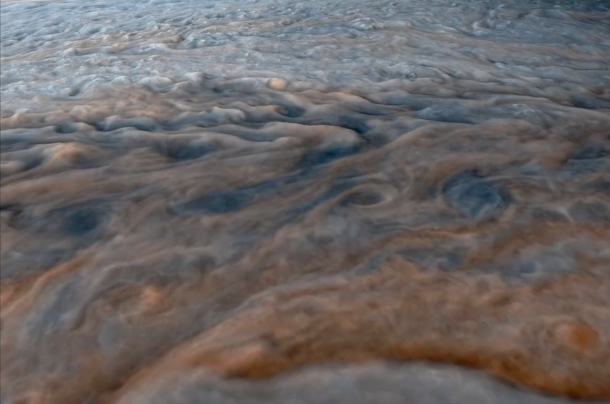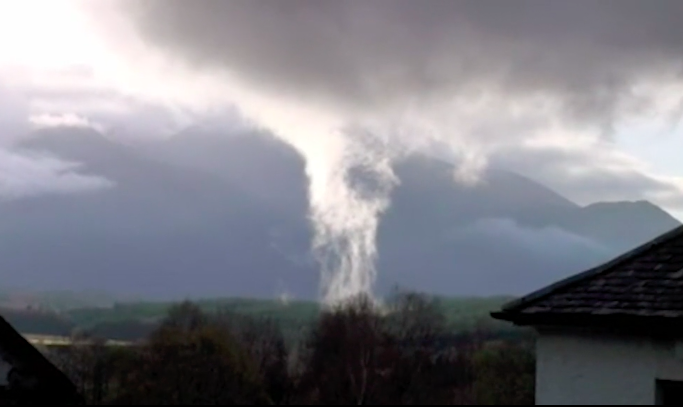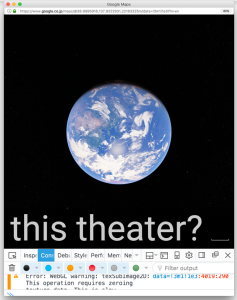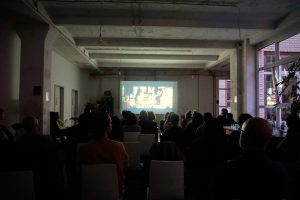
with GEOSTORM
a film by EDWARD GWYN JONES
Two days after Donald Trump’s inaugural speech as president, which effectively declared war on the respectful transition of constitutional power in the United States, I vowed to keep a diary of the lies and distortions unfolding daily in the media—a kind of trail of breadcrumbs into an unknown forest. It was the introduction of the term “alternative facts” that day by Kellyanne Conway, counselor to the president, that made me worry things might go so far through the political looking glass that it would become impossible to remember what had actually happened. My project lasted about twenty days before it was too much to bear.
I wish now that I had kept it up, even intermittently, because although I can remember having several instances of searing awareness, of grounded discourse seeming to dissolve, I can no longer reconstruct the specific fact patterns. Still, one overall pattern definitely recurred. Whenever, without fail, something incriminating or lurid popped up in the press that might have tarnished him, President Trump would lob a distracting and preposterous hand grenade into some aspect of foreign or domestic policy, creating enough mayhem or outrage that the press, dutifully, reflexively, and without making the connection, switched their collective attention and left the topic threatening to Trump behind, like cats frenzied by catnip.
This catnip-grenade technique rendered him in nearly-total control over the twenty-four-hour news cycle, or at least until the impeachment process and Covid-19 managed to upstage him from time to time. However, by then his “Fake News” mantra had effectively achieved the objective that Soviet propagandists had perfected during the last century: disable dissent by assaulting objectivity and reframing truth. The lure of this kind of reinvented truth is in its offer of vicarious, if illusory, power and meaning through identification with an authoritarian transference object that has the power to frame it: reasoned analyses of complex information are snobbery, but lurid, ridiculous conspiracies are Truth; Russia was not meddling in the 2016 US election, Democrats were meddling in Trump’s campaign, just like they are using a Covid hoax to make a heroic Trump look weak. In this rendition of the hero-as-victim, the primitive hero not only emanates seductively raw, crude power lust, but simultaneously becomes one with whom the victims of disorienting globalization can identify and through whom the rage of cumulative confusion and humiliation can be channeled. The narcissistic wound of disenfranchised singularity and superiority finds it revenge.
I was right. It is hard now to remember, step by step, how we have ended up not just in a clash of cultural values or political visions, but in weaponized and diametrically opposed narratives about reality. Uncertainty fuels anxiety, in general, but when the stakes involve basic assumptions about the world and one’s identity in it, the anxiety takes on existential proportions. In states of near panic, whether about dangers imagined or real, humans are prone to decreased memory function and nuance in decision making. Very little reason, as such, persists when the primary activity of the brain shifts from the cerebral cortex to the survival centers of the reptilian midbrain. In the extreme, we reduce to Aggression (Fight) or Fear (Flight). Eventually though, with unrelenting, chronic, and overwhelming stress, learned helplessness looms as a solution. This is what totalitarian states rely upon for their existence.
I remember talking gingerly with a colleague in Moscow a few years back about how she perceived the role of politics in her life. She told me that, for her, politics had no moral meaning beyond the garden area behind and between the apartment buildings on her block, which the neighbors tend and share. She relegated the actions of politicians and power brokers to a different, essentially amoral, mechanistic dimension that she chose to regard as irrelevant to her daily life. I understood instinctively how ultimately necessary that dissociation must have been. Preserving that residual sphere of moral concern, the garden and the people she knew, was at the same time her grip on the core of her humanity.
It was during this conversation that I first grasped viscerally the critical importance to totalitarian systems of achieving the surrender of reason. The crux of the surrender is the abandonment of reflection, whether by subservient adherence to symbolic figures or ideas—the patriot version—or by defensive repudiation of their relevance—the cynic version. In both cases, the assault on truth is instrumental. Once the possibility for an objective, rational conclusion has been eliminated, one can either latch onto a fantasy solution through a political transference object—whether a personality or a narrative—or retreat into the alternate, wishful solution that the object has no real meaning in one’s life. But a totalitarian state gets only part way with seductive fantasies. For those who don’t succumb to the proffered identifications, learned helplessness is required to cement control.
The American public seems today far from ready for surrender to learned helplessness. Indeed, achieving complete subjugation would require the kind of brutally violent oppression that totalitarian systems use to secure their hold. But deconstruction of objectivity—and the epistemological nihilism that results—is a crucial first step towards population surrender. And that, combined with an interminable state of Fight or Flight, is where it could lead.
GEOSTORM (2020)

In Geostorm, California is a metaphor. It is a failed neoliberal utopia perpetually providing accelerant to its own destruction. Hollywood, through the production of cultural normalization, imagines in abstract its own demise, as the land it sits upon bubbles with heat.
Geostorm looks at the seismograph beneath the movie studio. It explores how our psychological, physical, and digital distance from catastrophic events stratifies and compartmentalizes actively pressing realities. It does so through the internal language of California, taking the media and language of consumption and dissemination, mostly viral video and products of the California culture industry, as its form.
Geostorm critiques a desensitizing and distancing media environment whilst simultaneously attempting to reckon with our complicity as viewers and consumers in this construction. Music functions here as seductive affective glue, a rhythmical sphygmomanometer. This tension operates as a core method of Geostorm which continuously unsettles and seduces the viewer, a microcosm of a brain repeatedly incised by catastrophes happening outside of its physical perception.
At points, amongst the sometimes challenging footage, Geostorm turns on its screensaver, Jupiter. A spatial and temporal break, a gassy giant of endless storms and toxic atmosphere. An idea far enough away to be imagined, but close enough to see the endless rumble of its great red spot.
Geostorm is concerned with perceptual notions of flight, the distance and abstraction of land viewed from above, with the omnipresence of a camera racing towards a planet. If flight condenses time and geography then Geostorm precipitates instant global arrival through the screen and via networks, an instantaneous flight.
DR STEPHEN SETTERBERG publisher
Dr. Stephen Setterberg is Publisher of Stillpoint Magazine. He is a psychiatrist and psychoanalytic psychotherapist who founded and developed the PrairieCare system of clinics and hospitals for children and adolescents in Minneapolis, Minnesota, USA. While later training in Zurich to become a Jungian analyst, Stephen co-founded Stillpoint Spaces, a forum for psychologically-minded individuals of diverse cultural and educational backgrounds to utilize insights from psychoanalysis, psychotherapy, and related fields, with centers in Berlin, London, Paris, and Zurich. He also co-directs Confer, a UK organization first established by psychotherapists in 1998 to provide interdisciplinary continuing education for psychotherapists, psychologists, and other mental health workers.
EDWARD GWYN JONES artist
Edward Gwyn Jones, from Stoke-on-Trent UK, is currently studying for his MFA at the Glasgow School of Art, Scotland. Working primarily with moving images, Edward is interested in the entanglement of the catastrophic and the routine.
GEOSTORM (2020): Video with sound, 16:28min.
© Copyright for all texts published in Stillpoint Magazine are held by the authors thereof, and for all visual artworks by the visual artists thereof, effective from the year of publication. Stillpoint Magazine holds copyright to all additional images, branding, design and supplementary texts across stillpointmag.org as well as in additional social media profiles, digital platforms and print materials. All rights reserved.


